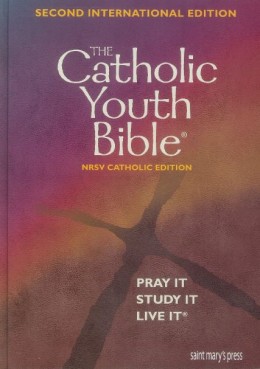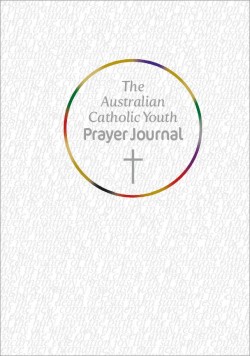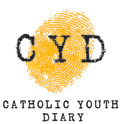- Home
- Issue 10: Care for Our Home
- Issue 9: Eco-Spirituality
- Issue 8: Interfaith Understanding
- Archives
- About us
- Contact
For Secondary
Devotion to May as the mother of God and mother of the Church has been a consistent dimension of the Christian faith. Yet how does Mary remain relevant in today’s world and to today’s teens?
The following is resources are designed to assist you in your important work – dissecting Mary’s role in the Church and the lives of your students.
The Hail Mary
Hail Mary, full of grace.
Our Lord is with you.
Blessed are you among women,
and blessed is the fruit of your womb,
Jesus.
Holy Mary, Mother of God,
pray for us sinners,
now and at the hour of our death.
Amen.
Other Prayers
Alternative prayers celebrating Mary’s place and importance in the world as the Holy Mother and the Mother of Jesus from The Australian Catholic Youth Prayer Journal by Ann M. Rennie.
- Hail Holy Queen Pg 201
- Rosary Pg 203
Suggestions on how to use these prayers:
The Latin version, Ave Maria, is popular with many vocalists—even today’s stars such as Beyonce and Michael Buble.
Discuss why has this prayer endured. Why is it timeless? What appeals to us about its simplicity? Where does it come from in the scripture? (Annunciation)
It’s an important element of the rosary, as it is ‘Mary’s prayer’.
Listen to any version of the song, Ave Maria, and reflect on its meaning and why song lyrics with music can be more powerful than prayer on its own.
Rosary
Prayer beads are used in many other religions: Hindu, Buddhist, Muslim and Jewish. They have a meditative effect on those using the beads, as they repeat the prayers in a chant-like manner. The spiritual themes, such as the Sacred Mysteries, are a way of storing religious events in our conscious minds.
Try meditating by saying parts of the rosary, such as repeating ‘Hail Mary’.
Look at why it is an effective way to silence the mind.
The early Christians used the rosary as a way to remember the life of Christ through Mary’s eyes as witness. The Buddhists use mantras in a similar way. In what way can you use a simple mantra or affirmation?
Create an altar to Mary, with students bringing in seasonal samples from nature to celebrate Mary’s feast days: flowers, candles, bark, river pebbles, leaves, blossoms, gum nuts, feathers. Link Mary’s life and feast days to nature’s cycles and the seasons, especially winter, spring and the beginning of summer when Mary’s feast days are most close together.
Final Prayer
Mary, Mother of Jesus, Bless this generation of your children
So that we too may live in the shining Resurrection of your son, forever and ever.
Scripture
Feast Day: The Assumption of the Blessed Virgin Mary
Reading: Luke 1: 39–56
Text: The Catholic Youth Bible, Pages 1205–1206
Text: The Australian Catholic Youth Prayer Journal, Ann M. Rennie, p. 128
Read the following biblical verses aloud.
Explain the context of these verses:
- Mary visits her cousin Elizabeth, who was also expecting a baby (John the Baptist). Both are pregnant through divine intervention and it is in this meeting that they encoutner their destinies as mothers of great leaders.
- Elizabeth greets Mary (Luke 1: 42–43) and says, ‘Blessed are you among women’, and ‘…the mother of my Lord.’
- Mary’s response (Luke 1 45–47) is: “All generations will call me blessed.” It is here that she understands the greatness of her task as mother of Jesus—from the crib to the cross.
The section known as Mary’s Song of Praise and the Magnificat is one of the most well-known passages in the scriptures. Luke: 46–56 is known as the Magnificat and shows Mary’s trust in God, privileged to be chosen to be Jesus’ mother.
This reading above is for the feast day of The Assumption. That is, the day Mary dies and her body and soul are taken up to heaven from her tomb. The Assumption of Mary into heaven is an infallible belief of the Catholic Church as confirmed in 1950 by Pope Pius XI.
Reflection:
How does your soul magnify the Lord?
Facts and Inquiry
Feast Days are to remind us of special days in the Church year. Our devotions to Mary in the changing of seasons are an important part of our liturgical lives.
References:
The Australian Catholic Youth Prayer Journal, Ann M. Rennie
Mary and seasons of prayer: pp. 86, 100, 120, 122, 128, 150, and 176.
Mary’s Feast Days August through to December: Winter through to Summer
Assumption of the Blessed Virgin
Commemorates the death of Mary, and her body AND soul being taken up to heaven from her tomb.
Mary’s body has never been found and there is no known tomb she may have been buried in. In Catholic teaching (dogma), she was ‘assumed’ into heaven both body and soul. In other words, her body did not decay as she was raised up to heaven by the angels. Prior to Mary only three others had ‘ascended’: Enoch, Elijah and Jesus.
In Eastern Orthodox belief, it was called the Dormition—the ‘falling asleep of Mary, the Mother of God.’
Suggested Classroom Activities
- Research into Christian beliefs of ascension and why it is so important as an ‘infallible’ belief in the Catholic Church
- Google images of Mary and the Assumption by famous artists e.g. Rubens, Titian, Poussin and compare the different versions of Mary’s assumption into heaven. Is it scientific or spiritual imagery? Explain your views on stylistic variations of artists and what message they were portraying.
http://tinyurl.com/koj6mdx
The Queenship of the Blessed Virgin*
Celebrates Mary’s reward for accepting to be the mother of Jesus. Her titles include Queen of Heaven and Queen of Angels.
Suggested Class Activity
Discussion
Was Mary adopted by early Christians because they were familiar with the pagan goddesses and so were able to replace them with her?
Look up Isis (an Egyptian goddess) whose son, Horus, was always depicted on her lap. She was known as god-bearer—the same title as Mary (the Theotokos, which means mother of God or God-bearer) given to her at the Council of Ephesus in 431 CE.
Sept 8 – The Birth (nativity) of the Blessed Virgin
Mary’s birthday: We celebrate Mary’s birth to Jaochim and Ann.
Sept 12 – The Most Holy Name of the Blessed Virgin
Celebrates the name of Mary – Miriam, in the Jewish tradition. Mary was called many other names, such as Queen of peace and Star of the Sea.
Suggested Class Activity
Names are important as they define who we are. The Blessed Virgin Mary is known as the merciful, the ever-patient mother, our protectress … and many more titles.
List the names Mary is known by to highlight her importance as Jesus’ mother, Mother of the Church and our spiritual mother.
See Litany of Loreto:
http://www.ewtn.com/faith/teachings/maryd6f.htm
List what your names would be (as in qualities and roles). E.g. Protector of the Weak or Animals, Patient Daughter/Son. How important could these names be to your sense of identity?
Sept 15 – Our Lady of Sorrows
We recognise Mary for her suffering. The title ‘Our Lady of Sorrows’ refers to Mary’s suffering during the passion and death of Christ.
Sept 21 – Presentation of the Virgin Mary
This date celebrates when Mary’s parents dedicated her to God in the Jewish temple when she was 3 years old.
Oct 7 – Our Lady of the Rosary
Celebrates Mary protecting us and reminds us to pray to her.
Dec 8 – Immaculate Conception of the Virgin Mary
Commemorates the feast day when Mary was conceived (pure).
Suggested Class Activities
Art: Research and Discussion
Look at art depicting Mary
- What are the common features? Compare the orthodox icons (Theotokos) to Renaissance art: how do they differ?
http://blog.theotokos.co.za/?page_id=851
- Why do different cultures represent Mary in their own individual way?
See Latin American, Indigenous, African and Western styles of Mary images
- Create a CD of images of Mary in groups and present to the class
- Create a calendar of Marian feasts using the seasons to reflect on the meaning of the feast days
- Mary’s life. ‘Mary – A Most Uncommon Woman. She was God’s Salvation Plan and chosen from the very beginning.(Isaiah: 7:14).’
In response to this statement, create a biography using the Gospelsand the mysteries of the rosaryas references. Show on the map where she lived and travelled to and from and what is happening there today (link with curriculum about world events/history/social studies). Create a documentary, using mediums such as film or PowerPoint.
- Mary has appeared on earth many times since her death.
In small groups, research places she has appeared (now shrines) and the miracles she has performed there, e.g. Fatima, Lourdes, Africa (more recently). Present the findings to the class and put forth the spiritual and scientific explanations for these phenomena.
Lesson Plan
The lesson plan for Mary is available from the button below.






